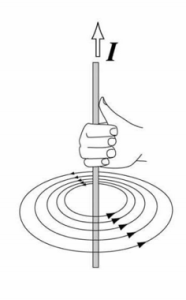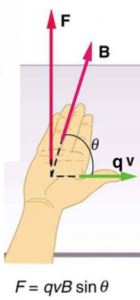Homework
All of the homework for this unit can be found at this link.
Given that this unit is short, so is the homework!
- Only moving charges (i.e. currents) generate and feel magnetic fields
- The field is “real” and the key object (just like for electricity)
- Moving charges make fields which can then exert forces on other moving charges
- Use your right hand: thumb in current ( [latex]\vec{I}[/latex]or [latex]q \vec {v}[/latex] ), fingers in [latex]\vec{B}[/latex]
- For the direction of a magnetic field, fingers curl in direction of [latex]\vec{B}[/latex]

- [latex]\vert \vec{B} \vert = \frac{I \mu_0}{2 \pi r}[/latex]
- [latex]\mu_0[/latex] is another universal constant like [latex]h[/latex], [latex]c[/latex], [latex]\varepsilon_0[/latex], and [latex]\mu_0 = 4 \pi \times 10^{-7} \frac{N} {A^2}[/latex]
- For the force, palm “pushes” in the direction of [latex]\vec{F}[/latex]

- [latex]F = qVBsin\theta[/latex] or [latex]F = ILBsin\theta[/latex]
- Result is particles in uniform [latex]\vec{B}[/latex] move in circles!!

